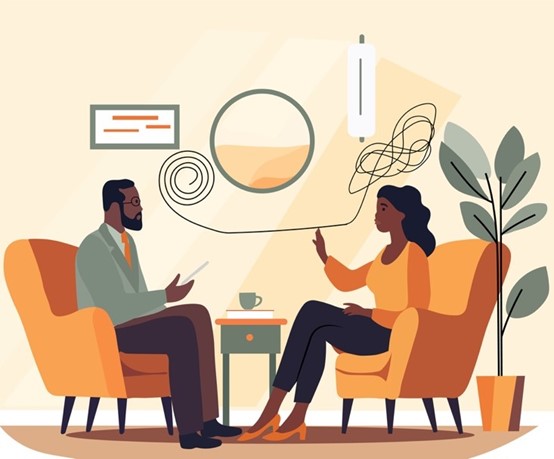Understanding Solution-Focused Brief Therapy
Solution-Focused Brief Therapy (SFBT)[1] is a therapeutic approach designed to address clients’ current issues by focusing on solutions rather than problems. Developed in the late 1970s by Steve de Shazer and Insoo Kim Berg[2], this model emphasizes clients’ strengths and resources, aiming for rapid and practical changes.
Core Principles
Focus on Solutions, Not Problems
SFBT shifts the focus from diagnosing problems to finding solutions. The approach assumes that clients have the skills and resources needed to solve their issues but may need help uncovering and applying them.[3]
Goal-Oriented
Therapy is centered around the clients’ goals.[4] The process involves identifying what clients want to achieve rather than dwelling on the difficulties they face. Goals are often formulated in a concrete and specific manner to facilitate tangible progress.
Strengths and Resources
The approach recognizes and builds on clients’ existing strengths[5] and resources. Therapists help clients identify past successes and skills that can be leveraged to address current challenges.
Future-Focused
SFBT emphasizes envisioning a future where problems are resolved. Clients are encouraged to imagine and work toward a preferred future[6], using this vision as motivation and a guide for change.
Brief and Time-Limited
As the name suggests, SFBT is designed to be brief. Therapy typically involves fewer sessions compared to traditional approaches, focusing on achieving noticeable changes in a relatively short period.[7]
Client Expertise
Clients are seen as the experts in their own lives. The therapist’s role is to facilitate the discovery of solutions and support clients in implementing them, rather than providing direct advice or solutions.
Therapeutic Techniques
The Miracle Question
This technique asks clients to imagine a future where their problem is miraculously resolved. It helps clients articulate their goals and identify the steps needed to achieve them.[8]
Exception-Finding Questions
Therapists ask clients about times when the problem was less severe or absent. Identifying these exceptions helps clients recognize their ability to manage and overcome challenges.
Scaling Questions
Clients are asked to rate their progress or feelings on a scale (e.g., 1 to 10).[9] This technique helps track improvements, assess progress toward goals, and motivate clients by highlighting incremental changes.
Compliments and Positive Reinforcement
Therapists use compliments to reinforce clients’ strengths and achievements. Positive reinforcement helps build clients’ confidence and motivation.
Coping Questions
These questions help clients explore how they have managed to cope with difficulties and what strategies they have used effectively in the past.[10]
Benefits of SFBT
Empowerment
By focusing on solutions and strengths, clients feel more empowered and capable of making positive changes.
Efficiency
SFBT’s brief and goal-oriented nature makes it an efficient option for clients seeking quick and practical solutions.
Positive Outlook
The approach fosters a positive and hopeful outlook, which can enhance clients’ motivation and engagement in the therapeutic process.
Flexibility
SFBT can be adapted to various settings, including individual, family, and group therapy, making it versatile and applicable to diverse client needs.
Considerations
While SFBT is effective for many clients and situations, it may not be suitable for everyone. It may be less effective for clients with complex or deeply entrenched issues that require more in-depth exploration and long-term treatment.
In conclusion, Solution-Focused Brief Therapy offers a practical and optimistic approach to addressing clients’ challenges. By focusing on solutions, leveraging strengths, and setting clear goals, SFBT empowers clients to create meaningful and lasting change in their lives.
[1] Kim, Johnny S. “Examining the effectiveness of solution-focused brief therapy: A meta-analysis.” Research on Social Work Practice 18.2 (2008): 107-116.
[2] Duvall, James D., and J. Marshall Beier. “Passion, Commitment, and Common Sense: A Unique Discussion with Insoo Kim Berg and Michael White.” Journal of Systemic Therapies 37.4 (2018): 45-67.
[3]Saggese, Michael L., and Frederick W. Foley. “From problems or solutions to problems and solutions: Integrating the MRI and solution-focused models of brief therapy.” Journal of Systemic Therapies 19.1 (2000): 59-73.
[4] Quick, Ellen K. Doing what works in brief therapy: A strategic solution focused approach. Academic Press, 2008.
[5] Zhang, Anao, et al. “The effectiveness of strength-based, solution-focused brief therapy in medical settings: a systematic review and meta-analysis of randomized controlled trials.” Journal of behavioral medicine 41 (2018): 139-151.
[6] McNulty, Carol P., and LeAnne Ward Smith. “Experiencing the future: preservice teacher perceptions of the solution-focused brief coaching approach.” International Journal of Mentoring and Coaching in Education 11.1 (2022): 35-51.
[7] Peller, Jane, and John Walter. “Solution-focused brief therapy.” Paradigms of Clinical Social Work. Routledge, 2020. 71-92.
[8] De Shazer, Steve, et al. More than miracles: The state of the art of solution-focused brief therapy. Routledge, 2021.
[9] Lee, Mo Yee. “The miracle question and scaling questions for solution-building and empowerment.” Social workers’ desk reference (2015): 308-316.
[10] Lutz, Anne Bodmer, and Insoo Kim Berg. “Solution-Focused Brief Therapy.” Editors-in-Chief (2002).







